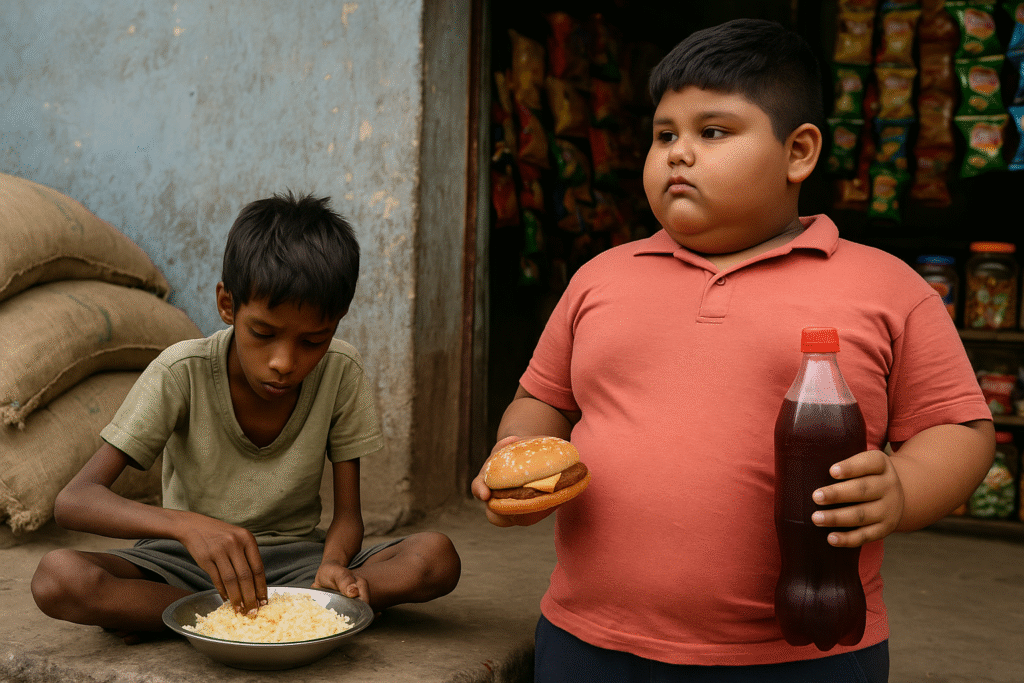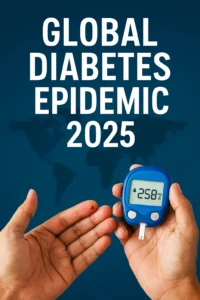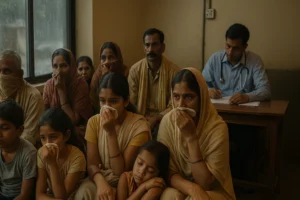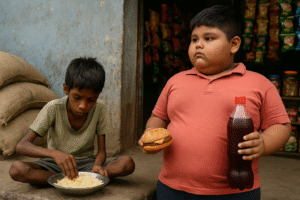Nutrition Transition: Why Obesity and Hunger Now Share the Same Table

The global nutrition transition 2025 highlights how undernutrition and overnutrition now coexist—even within the same communities.
A few months ago, I visited a slum in eastern Delhi where a family of five survived on just two meals a day—rice and a packet of masala-flavored noodles. Down the road, in a shiny air-conditioned supermarket, shelves overflowed with chips, frozen fries, and fizzy drinks, all well within reach for another set of Delhiites.
This wasn’t irony. It was reality. It’s also the story of the global nutrition transition 2025, where food is everywhere, and yet, proper nourishment is nowhere to be found.
The global nutrition transition 2025 has not just changed what people eat—it has transformed how people access, think about, and prioritize food. In many developing countries, this transition is happening faster than public awareness or policy can keep up. With rising incomes and urbanization, people are shifting away from traditional diets toward processed and packaged foods, often unaware of the health consequences. This shift is a defining marker of the global nutrition transition 2025, where convenience and marketing frequently outweigh nutritional value.
Table of Contents
1. When Calories Don’t Mean Nutrition
For decades, we were told that malnutrition looked like starving children in refugee camps. And yes, that image still holds true in pockets. But in 2025, there’s another image just as haunting: a teenager with obesity and anemia at the same time.
Across India, Brazil, Nigeria, and the Philippines, it’s no longer surprising to find households where one child is underweight while the other is battling early-onset diabetes. That’s not a statistical fluke—it’s the new global normal.
2. The Two-Faced Crisis
Health experts call it the “double burden of malnutrition”—the coexistence of undernutrition and overnutrition in the same population. What’s feeding it? A mix of cheap, calorie-dense foods and the vanishing availability of affordable, nutrient-rich alternatives.
What’s tragic is that this isn’t happening only among the poor. In middle-class families too, convenience often trumps quality. When both parents work long hours, the easiest option becomes processed food. The result: full bellies, but empty of nutrients.
3. Poor Diets Are Often the Only Option
I met a domestic worker in Mumbai last year who told me she gives her children white bread with butter and tea for breakfast—not because she thinks it’s healthy, but because it’s fast, filling, and costs less than ₹15.
She’s not alone. In urban neighborhoods from Jakarta to Johannesburg, fresh produce is either too expensive or too far away. Meanwhile, heavily marketed snacks are everywhere—from paan shops to petrol pumps.
It’s hard to blame individuals when the entire food system is stacked against them. That’s the heart of the global nutrition transition 2025: people don’t eat poorly because they want to—they eat poorly because the system leaves them no better choice.
4. Corporates Feeding the Crisis
Let’s not pretend this happened naturally. The processed food boom wasn’t some organic trend—it was a business strategy.
Global food giants flooded low-income markets in the 2010s with cheap, ready-to-eat products. Noodles, soda, chocolate bars, potato crisps—they became the “new normal” faster than local farmers could keep up. In some African and Asian countries, these brands are even viewed as status symbols.
The marketing wasn’t subtle either—celebrities endorsed junk food in prime-time ads, and products entered schools through sponsorship deals. In hindsight, it was never about feeding people. It was about capturing markets.
5. Public Health Systems Are Still Catching Up
Health systems in much of the world weren’t built for this kind of crisis. They’re still wired to deal with infections and maternal care—not chronic diseases in 10-year-olds.
In many government hospitals across South Asia, you’ll now find wards where children are treated for both rickets and obesity-related joint pain. Some nurses quietly confess they never thought they’d see “fat malnourished kids”—but here they are.
This is what the global nutrition transition 2025 has done: blurred lines, flipped definitions, and left doctors scrambling for updated playbooks.
You can also read Foods to Boost Immunity During Monsoon: A Rainy Season Diet That Actually Works.
6. It’s Not Just What We Eat, But What We’ve Lost
One grandmother I spoke with in Kerala blamed television for the change. “We used to cook everything from scratch,” she said. “Now they want pizza from the phone.” She wasn’t wrong.
Beyond ingredients, we’ve lost something cultural too: time spent cooking, traditional recipes, seasonal diets. Many youth today don’t know what a millet looks like—let alone how to cook it. The invasion of processed food didn’t just change what we eat; it erased how we think about food altogether.
7. Fixing the System, Not Just the Plate
If we’re to reverse this, the fix can’t be individual. We need policies—real, enforceable ones.
Taxing sugary drinks helps, sure. So does front-of-label packaging like Chile’s bold black warning stickers. But we also need grassroots work: rebuilding local food systems, subsidizing fruits and vegetables, and protecting kids from junk food marketing.
And let’s be honest—this will ruffle feathers. Food corporations won’t go quietly. But if we don’t change course now, we’re locking ourselves into a future of malnourished generations living shorter, sicker lives.
8. Final Bite: The Real Hunger
To address the challenges of the global nutrition transition 2025, governments and communities must go beyond calorie-counting. This transition demands structural changes—reimagining agriculture, regulating harmful food advertising, and investing in nutrition education.
Here’s what makes this paradox so cruel: we now live in a world where you can be overweight and malnourished at the same time.
The global nutrition transition 2025 isn’t just a health issue. It’s an equity issue, an economic issue, a political one. Until we stop treating hunger and obesity as separate problems, we’ll keep failing at both.
So the question isn’t “are people eating?” anymore. The real question is—what are they eating, and why is that all they have?
You can also read The nutrition transition to a stage of high obesity and noncommunicable disease.





